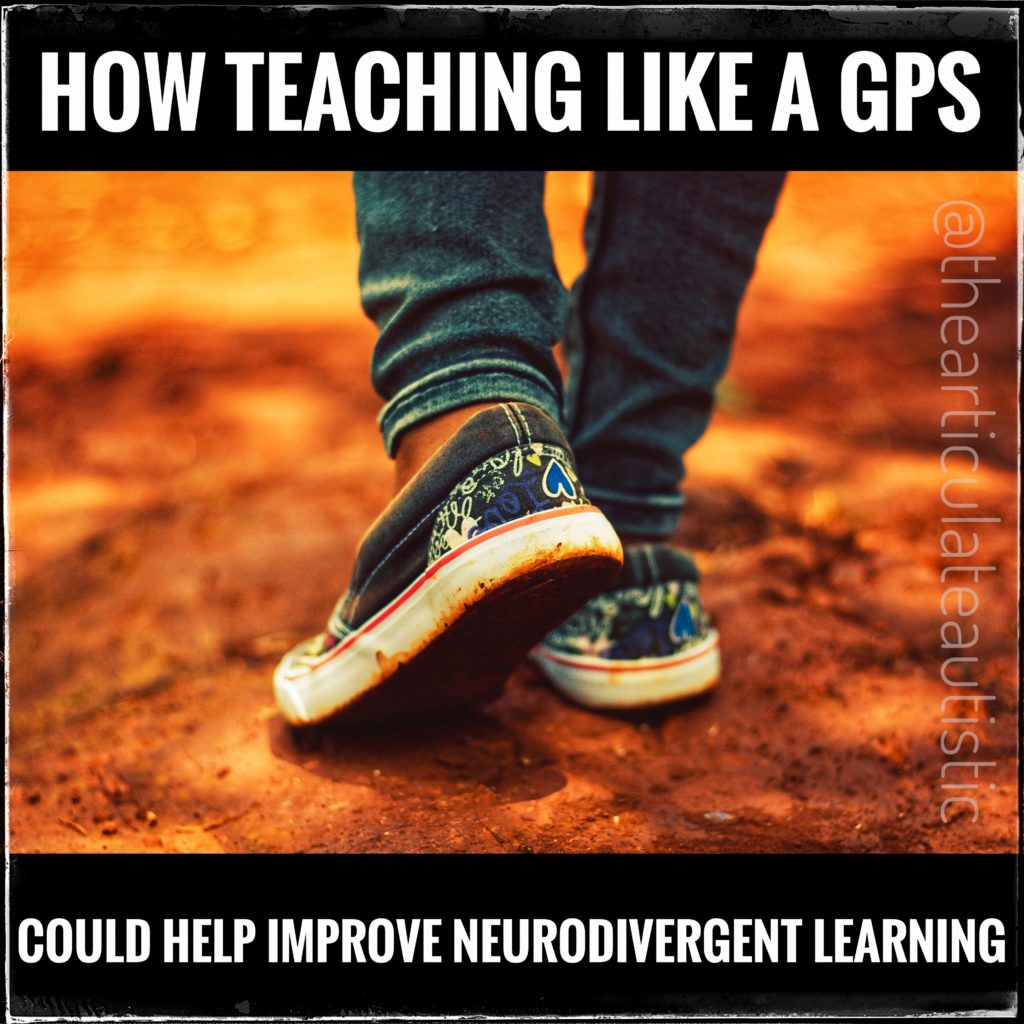How Teaching Like a GPS Could Help Improve Neurodivergent Learning

I’m old enough to remember when GPS wasn’t a thing. In fact, I always joke that I “invented” it because I often wished aloud that there was something in existence that gave turn-by-turn directions for driving–and a few years later, WHAM, the first GPS hit the market.
Before GPS, leaving the house was a gamble for me. If I was driving somewhere I knew and was familiar with, I was fine. If I had to drive somewhere new, I had to print out MapQuest directions and grip them in one sweating hand while I used the other to nervously clutch the steering wheel, and I only arrived successfully at my destination about half the time.

Because I’m autistic, and I also strongly suspect I have ADHD, I can’t hold more than 3 steps of any given information in my head at one time. Whether it’s physical directions to a place, instructions on how to do something, or a grocery list, if it’s more than 3 things, one of the steps is bound to leak out of my ear and fly away while I struggle and fail to hold it in my mind.
Thankfully, I have an amazing partner who understands this. She’s teaching me how to cook right now, and she’s the only person I’ve ever allowed to do that because she actually understands how she needs to talk to me so I get it.
I call it “GPSing”. She basically gives me turn-by-turn or, in this case, step-by-step instructions broken down into bite-sized chunks that I can remember and act on. Instead of giving me all the information at once, which I won’t retain, she gives me a step, then I ask her for the second step, she gives it to me, I ask her for the third step, she gives it to me, and so on.
So, for example, let’s say I’m prepping something (cutting, rinsing, etc.), she tells me how to do that first. Then, I ask for the second set of instructions, and she tells me what pan or pot to get, what to use to grease it, what temperature to heat it at, what the food will look like when it’s ready for the next ingredient to be added, etc.
Don’t get me wrong. I do know how to cook basic meals for myself, but I’ve only ever cooked for survival so I don’t starve. I’ve never cared about flavor or finesse, but since I’ve started cooking for her, I’m trying new things, and new things are often not my friend because of my memory and learning challenges.
Won’t My Autistic Loved One Become Dependent on “GPSing”?
I’ve heard neurotypical people discuss concerns over their autistic loved ones becoming dependent on prompts, GPSing, scaffolding, and other modified learning techniques, and it’s a valid concern.
However, dependence will only occur if that task is simply not manageable for the person despite instructions being broken down repeatedly over a period of months*, or the person doing the teaching doesn’t teach with the goal of independence.
* In a case like this, more task modifications may need to be given, or the person may not be ready, and the teaching of this particular skill should be put on hold for now.
I’ll use the cooking example again. Since my partner has explained to me several times that onions should be cooked until they become clear (opaque, really), I’ve now retained that information in my long-term memory, and she doesn’t have to repeat that part anymore.
When teaching autistic people and those with ADHD, consistency and repetition are paramount to success.
And, pro tip: Once you’ve taught us one way, keep teaching us the exact same way until we’ve mastered it or we specifically request to learn it another way. This is critical to us being able to make a mental map of the task and continue to remember how to do it.
Practical Application of “The GPS Technique”
Let’s say you’re a parent of an autistic 8-year-old, and you want to teach them how to make their bed. Instead of showing them how to do it once or twice and then withdrawing all of your support and letting them do it (which you can often do with neurotypical children), do so more gradually.
First, start with scaffolding. You can read more about scaffolding here, but I’ll give you a brief rundown:
With scaffolding, you model what you’re trying to teach, while explicitly explaining everything you’re doing as you’re doing it. In this case, you’d show how to put the fitted sheet on a bare mattress while saying, out loud, “I’m putting the fitted sheet down on the mattress. First, I walk over to this corner, and I tuck this part of the sheet under the mattress like this. Then, I walk over to this corner, and I tuck this part of the sheet under the mattress like this.” And keep doing that until that part of the task is done. Then, do the same with the next step.

GPSing is very similar to scaffolding, only with this technique, you’re guiding with your voice while your child does the work. You’re basically giving turn-by-turn (step-by-step) directions as they go. And, just like a GPS, if they make the wrong “turn”, you can re-route and go back to the last step where they were confident.
The GPS Technique Works Great for Finding Things, Too!
In a recent Instagram post, I talked about how important it is to be very specific when you ask a neurodivergent person to get something for you from the next room. GPSing can come in really handy for this, too. Let’s say you’d like your roommate with ADHD to get a snack out of the kitchen. Instead of, “Hey, while you’re up, can you get me the chips?” Try, “Hey, while you’re up, will you get me the potato chips in the kitchen?” Your roommate walks into the kitchen. “They’re in the blue bag with a red chip clip on it.” Your roommate looks around for it, not seeing it. “I put it on the black rolling cart right next to the Skippy peanut butter on the third shelf down from the top.” The item is now visible and tangible, and your roommate is able to grab the chips and hand them to you.
A Few Things to Keep in Mind When Teaching a Neurodivergent Person
- We can’t learn when we’re stressed.
If we are experiencing sensory overload, we don’t feel well, we’ve had a bad day, or our environment is too loud or bright, learning will be almost impossible, and meltdowns are likely to occur.
- We can’t learn if we don’t trust you.
Many autistic people and those with ADHD have learning trauma. Meaning we’ve been yelled at, called names, or punished for not being able to learn in the same way or at the same rate as our neurotypical peers. This can lead to associating learning with abuse, and make our brains shut down as an involuntary self-preservation method whenever teaching is attempted.
Furthermore, even a mildly frustrated tone of voice can derail our ability to process information because it causes severe anxiety.
In order for a neurodivergent person to have a good shot at learning from you, they must trust that you are a safe person who will not get mad at them for not understanding.
- We need more breaks in between.
People with ADHD, especially, need frequent breaks in between when learning new skills due to challenges with focus and attention. Autistic people may be able to hyper-focus on the task at hand but may also get burned out quickly but not notice the feelings of burnout until we are nearing meltdown mode.
Furthermore, neurodivergent people who associate learning with trauma will often be on high alert the entire time (even if it’s not outwardly noticeable), and that can be draining and exhausting.
Schedule frequent breaks.
- We can’t always carry out a task at the same skill level each time.
Being neurodivergent often means being able to carry out a task successfully one day while not being able to even remember how to do it the next. This is often dependent on mood and environment, and it’s very important to not get caught in the trap of thinking the person is “just pretending” they don’t know what to do this time so they can get out of doing it. This is rarely the case. Neurodivergent skills and abilities have a tendency to wax and wane, especially in the earlier stages of learning a new skill. This is not lying or laziness, it’s just part of the differences in the function of the atypical brain.



As an autistic teenager who’s learning to cook, can I add, the notes app on my phone has been my best friend. My process of learning to cook a certain food starts with me volunteering to learn to make a new meal. Then the parent who I trust to give me instructions (mum) clears the kitchen so that only me and her are in there working (this reduces sensory overwhelm). Usually, I try to make sure it’s daytime because indoor lighting, no matter how dim, upsets me, so doing difficult tasks when it’s daylight is much easier. She gives clear GPS instructions and narration while making the meal and getting me to help with the meal (a mix of scaffolding and GPS). If I feel comfortable, I start to note the instructions down on my phone after she gives them, before acting on them. This helps me process the instructions and reflect on them. I also make sure to clear any clutter we’ve made away in between steps. Depending on the difficulty of the meal, it might take one or two of these practise runs before I can use the notes on my phone without my mum assisting me. Then after many practises, I develop the ability to not need my notes.
It’s wonderful how much I’ve managed since getting my autism diagnosis (and finding this website). In the months before it, I built up some mild learning trauma so that as soon as I was given an instruction I didn’t understand, I would freeze up, feel absolute terror, and start to make noises and eventually throw myself on the floor if the instructions weren’t made clearer. I still do this if my other parent tries to teach me to cook, because I only taught my mum how to help me, so my other parent doesn’t understand what type of instructions I need. But things have improved a lot. I can usually get through cooking without more than one freeze/fight/fight/etc response, and if I do get that response, I can carry on afterwards.
I think the more bad experiences of learning I went through, the more I struggled to follow instructions. If I couldn’t perfectly visualise what I was being asked to do – for example, if there were two directions I could tip the water into the pan – then I would enter flight-fight-freeze-fawn-flood mode (the panic responses). That was percieved as bad behaviour so I was told off more. I was terrified of the possibility of experiencing that terror so I refused to learn to cook. I felt unsafe as soon as instructions started to be given. I got worse at understanding instructions because any slight doubt I had became magnified – it was a potential source of danger.
Thank you so much for your continued commentary and sharing.
The rerouting part of the GPS technique is important
[especially if you are like me and cannot go back more than one or two steps].
I also find it hard to learn when I am in tired or in pain [you may have taken that in under “stress” – at least the physical aspects].
Yes, rerouting is SO important! Thank you for your comment. 🙂
Just wanted to give a huge hello! I followed your page a couple of years ago after my daughters diagnoses. You were such a huge help in helping me understand so many aspects of her world, her behaviors and how she perceived mine! So glad to see you have a blog and plan on reading my way through it all! Huge thank you for all you do!
You’re so welcome. I’m glad to help!
That’s awesome, Dawn! I’m so glad that my writing has been helpful to you and your daughter. That’s wonderful.
You call it GPSing, I called clear and detailed instructions. I mean in my own common sense how could someone ask you to get something and stop without giving actual details about the location, color, size… etc.
I relate with most of what you have written and I managed on my own to gaslight myself (actually I just told myself that, I am me and they are they. We are not the same and what is suitable for me might not be for others) Accept myself as I am. I was diagnosed with ADHD 20 days ago and I suspect that I might have ASD.
Thank you Jaime! I love all of your content, articles, and the most enlightening paradigm shifts while raising two boys on the spectrum. Any suggestions for shoe tying? They are twins age 10. One will struggle with the motor skills and coordination and the other will be riddled with anxiety when we can approach things in a more GPS friendly way. Thank you
Hi, Kat. Thank you so much for your comments. Honestly, I’d say slip-on or Velcro shoes. That’s just a personal choice for me. Coordination is very difficult for me, too because of dyspraxia, and although I’ve learned how to tie my shoes, I still do the “bunny ear” method at the ripe old age of 43. lol! Pick your battles. There’s nothing wrong with wanting them to learn to tie their shoes, but maybe that should come later if they are struggling that much with anxiety? Just my two cents. 🙂
Yes! Finally something about ADHD.